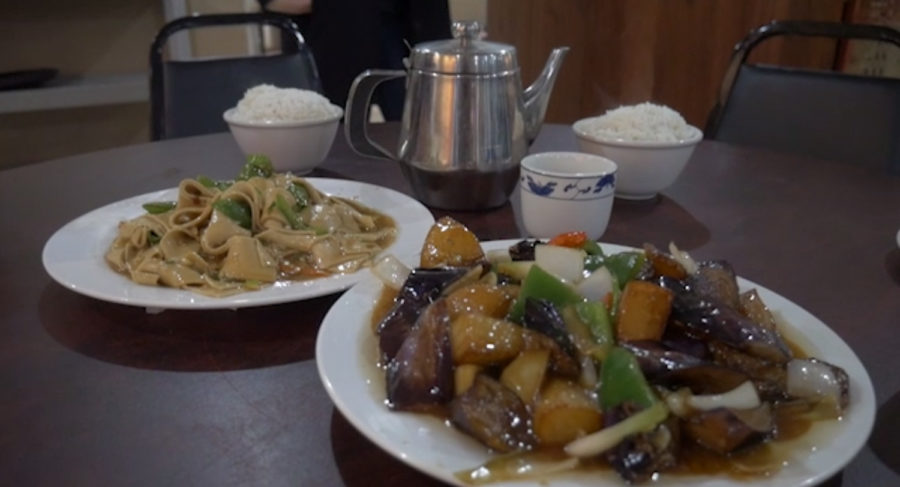Northeastern Kitchen brings traditional Chinese food to Pittsburgh
Levko Karmazyn | Staff Photographer
Squirrel Hill’s Northeast Kitchen serves Stir Fried Eggplant, Potato, and Green Pepper (right), and Dried Tofu with Chili Pepper.
April 3, 2019
Northeastern Kitchen is easy to miss. The Chinese restaurant sits in a basement on Forbes Avenue in Squirrel Hill with its narrow storefront nestled between a bank and a consignment store. Inside, it’s a cozy and humble space, sparsely decorated aside from the red tapestries that adorn the walls and the waving plastic cat that greets you at the cash register.
But don’t let the decor fool you — the menu is anything but typical. Instead of the classic General Tso’s chicken and lo mein, Northeastern Kitchen stays true to the cuisine from the region where it gets its name. In this case, “northeastern” refers to Heilongjiang, China’s northernmost province. A world away from the cultural hubs of Beijing and Shanghai, Heilongjiang is one of China’s agricultural and industrial hubs.
However, what makes Heilongjiang culture differ more from China’s other regions is its proximity to Russia. It has long been a region where the two countries have conducted trade. Waves of Russian immigrants, attracted by the need for labor to build a railroad, settled in the area in the mid-20th century. The result of mixing the two cultures can be clearly seen — or rather tasted — in the ingredients used in its food.
Heilongjiang is brutally cold. Whereas most heavily populated Chinese regions are in the warmer southwest regions, winter temperatures in Heilongjiang can dip down well below -30 degrees Fahrenheit. Because of this, there is a limited number of crops that can grow in time during the short growing season, such as corn, potatoes and barley. Unsurprisingly, these foods provide the base of many dishes you will find on Northeastern Kitchen’s menu.
Senior finance major Yan Liu (岩柳) manages the restaurant while her parents manage the kitchen. Levko Karmazyn — a videographer for The Pitt News — and I got the opportunity to sit down with her to discuss her experience managing such a distinct restaurant in Pittsburgh.
Restaurant management has always been part of Liu’s life. Before her family moved to the United States, they owned and operated a restaurant in her hometown of Shenyang. Liu moved to Pittsburgh six years ago with her mother, following her father who had already been living in the country and working as a chef for 20 years.
For Liu, it was an easy transition.
“My father first told my mom about Pittsburgh, ‘It’s so lovely.’ He loves it. I like it here, it’s really like my hometown, really similar. My hometown was about steel, like Pittsburgh,” Liu said.
Liu manages the front of house in an even-keeled manner, which contributes to the welcoming environment that the dining room emanates. It is clear that the restaurant has a dedicated following. Even as the lunch rush started to pick up, Liu found time to stop at each table to converse with the diners.
For those who aren’t familiar with traditional Chinese cuisine, the menu at Northeastern Kitchen can feel overwhelming. Chicken gizzards, cutlassfish and sliced kidney are sure to raise some eyebrows. Yet for the less adventurous eater, like myself, there are plenty of delicious options to choose from.
For a first-timer, I recommend ordering the sauerkraut dumplings to start, with a pot of barley tea to wash it down. The flavors are a perfect balance of sharp and mild — definitely sour, but not overwhelmingly so.
With such specific foods, Liu often has difficulty describing the dishes to new diners, as the menu itself offers no descriptions. As she would with any other diner, she slid a menu over to me and pointed to the dried tofu with chili powder.
“I think you’ll like this, it’s very good,” Liu said.
And she was right. The food, served in large enough portions to share, is hearty and mild, often fried in a thick sauce, in contrast to other styles of Chinese food such as mouth-numbingly spicy Sichuan cuisine.
On the cold and windy day when we stopped by, it was easy to imagine how such food would be comforting during the winter months of northeastern China. Mama’s shredded vegetable salad — Ma Ma Liang Cai — was a light, tangy and crunchy contrast to the heavier dishes.
After our meal, Liu gave me and the videographer a tour of the kitchen. Traditional Chinese cooking tools lined the stovetops. The air was filled with steam from the rice cooker as well as the Chinese broccoli that was being sauteed. Though two chefs were busy at work, they were more than happy to show off their cooking prowess. I watched in awe as one chef effortlessly tossed the vegetables around, being snapped back into reality as a waitress brushed by me, hands full with a plate of two entire steamed fishes.
The other chef pointed at the fish and proudly proclaimed “Yu!,” the Chinese word for fish. As a high school student, I had spent time working in restaurant kitchens. There was a tangible sense of pride and satisfaction in Northeastern Kitchen that other restaurants seem to lack.
Certain dietary differences have proved difficult for trying to operate a business in America. In Squirrel Hill in particular, which has a heavy Jewish population, she’s found its harder to sell dishes containing pork.
“[In northeastern food] there’s a lot of pork, but people here, they don’t like it. We cook more beef instead,” she said.
She also cited stringent health regulations and differences in tipping culture as two additional issues she was unprepared to face when operating a restaurant in the United States.
With such a strong business, Liu is confident that the future could hold more restaurant openings. But for now, she is satisfied that she has been able to establish herself in the community and give Pittsburghers a chance to try an entirely new type of food that is close to her heart.



